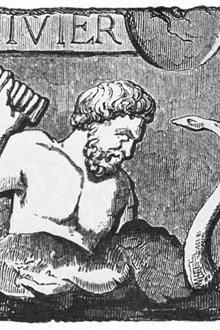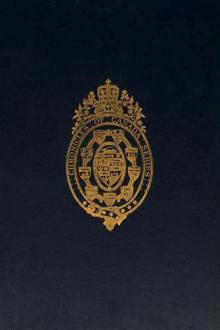Three Thousand Years of Mental Healing by George Barton Cutten (best large ereader txt) 📕

- Author: George Barton Cutten
- Performer: -
Book online «Three Thousand Years of Mental Healing by George Barton Cutten (best large ereader txt) 📕». Author George Barton Cutten
To-day, probably the most efficacious waters are to be found at the sacred fountain at La Salette and at the holy spring at Lourdes.
We have another specific form of healing which should be noticed. It was especially common in Eastern churches, and was found to some extent in the West. I refer to Incubation, or "Temple-sleep." This practice came down through early civilizations and was an adopted practice among Christians. The patient went to some church well known for its cures, which was provided with mattresses or low couches, and attended by priests and assistants. Devotions being finished he lay down to sleep. Sometimes he slept immediately, at other times sleep must be wooed by fast and vigil. At any rate, during the sleep he dreamed that the saint touched him, or prescribed some remedy, and in the first case he awoke cured, and in the second the prescribed medicine brought about the relief.
Sophronius, the Patriarch of Jerusalem, wrote about 640 as follows: "Cyrus appeared to the sick man in the form of a monk, not in a dream, as he appears to many; but in a waking vision, just as he was and is represented. He told the patient to rise and to plunge into the warm water. Zosimos said it was impossible for him to move, but when the order was repeated, he slid like a snake into the bath. When he got into the water, he saw the saint at his side, but when he came out, the vision had vanished." Beside the cure of this paralytic at the church of Cyrus and John, he mentions the cure of many other diseases by this method of incubation. Among them are dumbness, blindness, barrenness, possession, scrofula, dyspepsia, a broken leg, deformities of limbs, lameness, gout, diseases of the eyes, cataract, ulcer, and dropsy.
Among the churches of Greece and southern Italy incubation is still common. The climate may have some effect in limiting the area of this practice. Miss M. Hamilton furnishes us with some modern examples. In speaking of a new picture of St. George in the church at Arachova, she says: "It is a votive offering of a Russian, who came a paralytic to Arachova in July, 1905. He spent several weeks praying and sleeping in the church, and departed completely cured. The festival of St. George is held on April 23rd. They have three days of dancing and feasting, and at night all suppliants bring their rugs and sleep round the shrines in the church. Every year many of the sick are found to be cured when morning comes."
The Church of the Evangelestria, our Lady of the Annunciation, is visited by about forty-five thousand pilgrims every year. It is situated at Tenos, and Miss Hamilton tells us what she saw during her visit there in 1906:
"On the morning before Annunciation Day this year, the pilgrims could be seen making their way to the church. Among them were cripples, armless, and legless, half-rolling up the street; blind people groping their way along; men and women with deformities of every kind; one or two showing the pallor of death on their faces were being carried up on litters. These evidently were coming to Tenos as a last resource, when doctors were of no avail. Other pilgrims were ascending after their own fashion, according to vows they had made. One woman toiled laboriously along on her knees, kissing the stones of the way, and clasping a silver Madonna and Child. Last year her daughter had been seized with epilepsy, and she vowed to carry in this way this offering to the Madonna of Tenos if she would cure her daughter. The girl recovered and the other now with thankful heart was fulfilling her part of the bargain.
"The eve of Annunciation Day is the time when the Panagia is believed to descend among the sick and work miraculous cures among them. Then all the patients are gathered together in the crypt or in the upper church. The Chapel of the Well is the popular place for incubation. There is more chance for miraculous cure there than in the church. The little crypt can accommodate only a comparatively small number, but they are packed together as tightly as possible. From the entrance up to the altar, they lie in two lines of three or four deep, with a passage down the middle large enough for only one person. Down the narrow way two streams of people press the whole evening. They worship at the shrines along the wall, purchase holy earth from the spot where the picture was discovered, drink at the sacred well, and are blessed by the priest at the altar. The cripples and the sick desiring healing have been engaged all day in such acts of worship; they have received bread and water from the priests in the upper church, paid homage to the all-powerful picture, offered their candles to the Madonna, and all the time sought to endue themselves with her presence. Now at night, still fixing their thoughts upon her, and permeated by this spirit of worship, they settle down to sleep in order that she may appear to them in a dream.
"Disappointment, of course, awaits the vast majority, but on the evening of the vigil all are filled with hope. They know the precedents of former years, how such things have happened to some unfortunate people among the pilgrims every year. Usually eight or nine miracles take place, and lists of them are published for distribution....
"The church records contain accounts of the miracles which now amount to many hundreds. They are practically all of the type I have described—cure during a vision while incubation was being practised. For example, the case of a man from Moldavia is on record. He had become paralyzed during a night-watch, and the doctor could effect no relief. He was taken to the Chapel of the Well, and when asleep he thought he heard a voice telling him to arise. He awoke, thought it was a dream, and fell asleep again. A second time he heard a voice, and saw a white-robed woman of great beauty entering the church. In his fear he rose and walked about. His recovery was so complete that he could walk in the procession round the town the following day."46
The medicinal power imputed to the sainted relics and shrines would naturally be considered very valuable. So it proved. Wealth flowed to a conventual treasury or a cathedral chapter where were deposited fragments of the martyred dead endowed with miraculous puissance. When the Frankish forces sacked Constantinople at the beginning of the thirteenth century, the principal object of their ferocious cruelties and vigilant searches was the acquisition of precious relics. Concerning these relics Fort gives the following account:
"These relics, captured in Constantinople, were divided by the troops under Marquis de Montfort, with the same justice as prevailed in the division of other booty. In this way the Venetians were enabled to enrich their metropolis with a piece of the sainted cross, an arm of St. George, part of the head of St. John the Baptist, the entire skeleton of St. Luke, that of the prophet St. Simeon, and a small bottle of Jesus Christ's blood. The Greek capital from the remotest times appears to have monopolized this traffic in sacred wares, claiming to possess a fragment of the stone on which Jacob slept, and the staff transformed into a serpent by Moses.
"Here also were guarded the Holy Virgin's vestments, her spindle, drops of her milk, the cradle in which the Saviour had lain, a tooth from his adolescent jaw, a hair of his beard, a particle of the bread used in the Last Supper, and a portion of the royal purple worn by him before Pilate. Naturally clerical adventurers among the occidental Crusaders, pending the sacking of the Byzantine city, sought out most zealously these valuable remnants of pristine glory, and in obtaining them were by no means scrupulous with menaces and violence. When scattered through Western Europe, in the monasteries and other religious places, their curative properties increased the pilgrimages thither of the sick and diseased."47
He further gives us more in detail48 an idea of the continual accumulation of riches which were derived from the exposure of these relics to the sick and infirm and the consequent growth in wealth of the monasteries and cathedrals. The monastic system was probably most responsible for the change from the simple adoration of the early Christians to the use of relics as a miraculous means of healing. Those which were transported with elaborate ceremonies, enclosed in a magnificent stone sarcophagus, and covered by an edifice of imposing proportions were almost sure to bring to their custodians great wealth. It is said that when the body of St. Sebastian, which was legitimately obtained from Rome, together with the purloined remains of St. Gregory, reached the cloister of Soissons, so great was the crowd of invalids who were cured, and so generous were they in their donations, that the monks actually counted eighty measures of money and one hundred pounds in coin. The great value of such objects may be calculated when it is remembered that in the year 1056 securities amounting to ten thousand solidi were pledged for the production of the relics of St. Just and St. Pastor, consequent upon the legal decision of ownership between Berenger, a French ruler, and a Narbonnese archbishop. The Reichberg annals provide a further example. They state that the emperor demanded certain hostages, or the holy arm of St. George, as a suitable guarantee for the institution of a public mart in Germany.
Venetian merchants were among the first to realize the commercial value of relics, and enjoyed a lucrative traffic in this holy merchandise. It was not until the eleventh century, however, that the government of Venice founded public marts or fairs for the commercial exchange of saintly relics, although Rome and Pavia had long conducted such enterprises. These fairs were placed under the tutelary protection of some patron saint, the Venetians, of course, thus honoring St. Mark. They were not always particular how these relics were procured, for it is stated that when negotiations for the exchange of a well-preserved body of St. Tairise proved unsuccessful, because the Greek monks who possessed it refused absolutely to sell or barter, these enterprising traders quietly stole the desired skeleton.
Relics provided a suitable method of acquiring ecclesiastical fortunes for denuded cloisters or impoverished nunneries; and if the old relics lost their power it was not difficult to procure episcopal assurance of the miraculous powers of new ones. For the procuring of special funds the venerated objects were taken from place to place, under priestly surveillance, presented to the sick and infirm with assurance of relief, and with the demand for large sums of money.
We can easily understand, then, why such donations were regarded as most precious presents, and chronicled in the conventual records as events of high importance. As early as the ninth century, documentary evidence of authenticity frequently accompanied a





Comments (0)